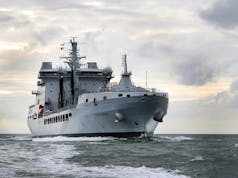RFA Lyme Bay has taken over the role of minehunter mother ship in Persian Gulf.
The support vessel has begun her mission as ‘mother ship’ to British and allied minehunters in the Gulf with a two-week Anglo-American workout the Royal Navy have announced. The role involves everything from resupplying the vessels to co-ordinating their operations. RFA Cardigan Bay (pictured) was the first Bay class vessel to undertake this role.
Captain Paul Minter said:
“Training opportunities like this have provided RFA Lyme Bay with the chance to refine our rafting skills and demonstrate that she is ready in all respects to carry out her duties.”
The vessel acts as a mothership through process known as ‘rafting up’, the Royal Navy describe this as “berthing alongside minehunters in the mid-ocean with giant fenders to prevent the vessels damaging each other.”
She will soon support all four of the Royal Navy’s force in Bahrain, HMS Penzance, Middleton, Chiddingfold and Bangor, plus two US Navy Avenger-class vessels, USS Sentry and Gladiator.
In September last year she spent six days off Dominica providing humanitarian and disaster relief following Tropical Storm Erika. Lyme Bay assisted with the search and recovery of EgyptAir Flight 804 which crashed over the Mediterranean Sea recently.
RFA Lyme Bay is a Bay class auxiliary landing ship dock, she entered service in late 2007 and was the last ship of the class to join the RFA, the first in class was sold to Australia.
The RN presence in the Persian Gulf typically consists of an escort vessel and a squadron of minehunters supported by an RFA Bay class “mothership”.













Cant we make the aussies an offer for the one we stupidly sold them….
Totally agree. We traded away a lot of very useful capability for not a lot of money (£65 million / $100 million AUD according to Wikipedia).
The SDSR 2010 really was insanely short sighted. A lot of the decisions needed to be made for sure, considering the mess the nations finances were in and the equal mess that the MOD costs were, but a few of them made zero sense like selling off one of the bays. Marginal cost saving but a reasonably relevant loss of capability.